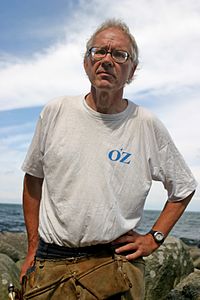In a nature preserve in southwest Sweden stands a nature reserve marked by two landmarks- a nine-foot tall tower named Nimis and a concrete sculpture called Arx.

Lars Vilks began the art project of creating Nimis in 1980. However, in 1982, the government noticed and foretold the necessary destruction of the tower. At first, to avoid government intervention, Vilks sold the work to Cristo, an artist. The deed of sale was on a piece of driftwood. Then, in 1996, Vilks declared the area an indpendent nation, henceforth called Ladonia. The strategy seemingly worked- the government did not tear down these artworks.
In 1999, Vilks built another sculpture named Omphalos, which was ordered destroyed by a court decision. Ernst Billgren bought Omphalos, and urged the sculpture simply be removed from the site without damage. The authorities did remove the sculpture, but harmed it in the process.
Vilks sought permission to build a monument in Omphalos' place and his request was granted- provided the monument be under 8 cm tall. Vilks accepted and completed the challenge.

Nowadays, Ladonia is 'engaged in war' with the satirical website of "The Armed Coalition Forces of the Internets," who demand no copyright laws and free internet access for all of Ladonia's citizens. Ladonia has no inhabitants, though it claims 15,000 citizens through online application. The website has confused people on this matter in the past, however, as roughly 3000 Pakistanis applied online for citizenship to Ladonia, were granted it, and then were unable to move there.
The micronation is a constitutional monarchy, and citizenship is free online. Lordship or ladyship costs only $30. Citizens contribute to the forming of a Ladonian language through suggesting a word in their citizenship application.
Sources: Wikipedia, Ladonia.org, Atlas Obscura.org